
The al-Hakim Mosque, nicknamed al-Anwar, is a historic mosque in Cairo, Egypt. It is named after al-Ḥākim bi-Amr Allāh (985–1021), the 6th Fatimid caliph and 16th Ismāʿīlī Imam. Construction of the mosque was originally started by Caliph al-ʿAziz, the son of al-Muʿizz and the father of al-Ḥākim, in 990 CE. It was completed in 1013 by al-Ḥākim, which is why it is named after him.
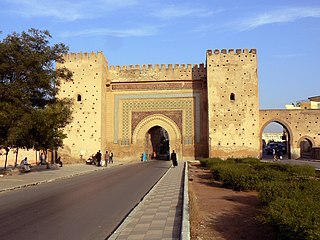
Meknes is one of the four Imperial cities of Morocco, located in northern central Morocco and the sixth largest city by population in the kingdom. Founded in the 11th century by the Almoravids as a military settlement, Meknes became the capital of Morocco during the reign of Sultan Ismail Ibn Sharif (1672–1727), son of the founder of the Alaouite dynasty. Sultan Ismail created a massive imperial palace complex and endowed the city with extensive fortifications and monumental gates. The city recorded a population of 632,079 in the 2014 Moroccan census. It is the seat of Meknès Prefecture and an important economic hub in the region of Fès-Meknès.
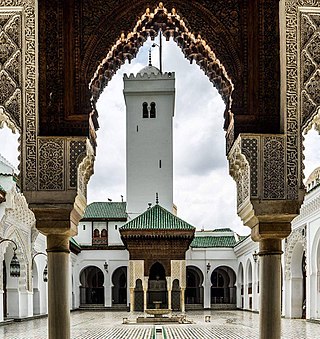
The University of al-Qarawiyyin, also written Al-Karaouine or Al Quaraouiyine, is a university located in Fez, Morocco. It was founded as a mosque by Fatima al-Fihri in 857–859 and subsequently became one of the leading spiritual and educational centers of the Islamic Golden Age. It was incorporated into Morocco's modern state university system in 1963 and officially renamed "University of Al Quaraouiyine" two years later. The mosque building itself is also a significant complex of historical Moroccan and Islamic architecture that features elements from many different periods of Moroccan history.

The Kutubiyya Mosque or Koutoubia Mosque is the largest mosque in Marrakesh, Morocco. It is located in the southwest medina quarter of Marrakesh, near the Jemaa el-Fnaa market place, and is flanked by large gardens.

Fes el Bali is the oldest walled part of Fez, the second largest city of Morocco. Fes el Bali was founded as the capital of the Idrisid dynasty between 789 and 808 AD. UNESCO listed Fes el Bali, along with Fes Jdid, as a World Heritage Site in 1981 under the name Medina of Fez. The World Heritage Site includes Fes el Bali's urban fabric and walls as well as a buffer zone outside of the walls that is intended to preserve the visual integrity of the location. Fes el Bali is, along with Fes Jdid and the French-created Ville Nouvelle or “New Town”, one of the three main districts in Fez.

The Bou Inania Madrasa or Bu 'Inaniya Madrasa is a madrasa in Fes, Morocco, built in 1350–55 CE by Abu Inan Faris. It is the only madrasa in Morocco which also functioned as a congregational mosque. It is widely acknowledged as a high point of Marinid architecture and of historic Moroccan architecture generally.

The Bab Berdieyinne Mosque is a mosque in the old city (medina) of Meknes, Morocco, a UNESCO World Heritage Site. The mosque was built in the early 18th century on the orders of Morocco's first female minister, Khnata bent Bakkar, and was constructed of rammed earth. It is named after the nearby city gate.

The Mosque of the Andalusians or Al-Andalusiyyin Mosque, sometimes also called the Andalusian Mosque, is a major historic mosque in Fes el Bali, the old medina quarter of Fez, Morocco. The mosque was founded in 859–860, making it one of the oldest mosques in Morocco. It is located at the heart of a district which was historically associated with Andalusi immigrants, from which it takes its name. It has been renovated and expanded several times since then. Today, it is one of the relatively few remaining Idrisid-era establishments and one of the main landmarks of the city.

Saffarin Madrasa is a madrasa in Fes el-Bali, the old medina quarter of Fez, Morocco. It was built in 1271 CE by the Marinid Sultan Abu Ya'qub Yusuf and was the first of many madrasas built by the Marinid dynasty during their reign. It is located just south of the 9th-century Qarawiyyin Mosque on Saffarin Square, which is named after the coppersmiths who work in the square.

Sahrij Madrasa or Madrasa al-Sahrij is a madrasa in Fez, Morocco. The madrasa is located inside Fes el Bali, the old medina quarter of the city. The madrasa dates back to the 14th century during the golden age of Fez under Marinid rule. The madrasa is located near Al Andalus Mosque and is also connected to another, smaller, madrasa built at the same time, the Sba'iyyin Madrasa.
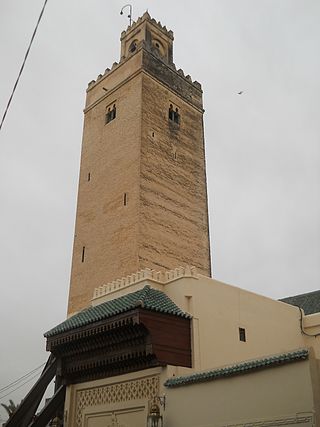
The Bab Guissa Mosque is a medieval mosque in northern Fes el-Bali, the old city of Fez, Morocco. It is located next to the city gate of the same name, and also features an adjoining madrasa.

The Chrabliyine Mosque is a Marinid-era mosque in Fez, Morocco.

The Ben Salah Mosque or Ben Saleh Mosque is a 14th-century Marinid mosque in the historic medina of Marrakesh, Morocco. It is the only major surviving Marinid-era monument in Marrakesh and is notable for its fine minaret.

The architecture of Fez, Morocco, reflects the wider trends of Moroccan architecture dating from the city's foundation in the late 8th century and up to modern times. The old city (medina) of Fes, consisting of Fes el-Bali and Fes el-Jdid, is notable for being an exceptionally well-preserved medieval North African city and is classified as a UNESCO World Heritage Site. A large number of historic monuments from different periods still exist in it today, including mosques, madrasas, synagogues, hammams (bathhouses), souqs (markets), funduqs (caravanserais), defensive walls, city gates, historic houses, and palaces.

The Grand Mosque of Meknes is the historic main mosque of the old city (medina) of Meknes, Morocco. It is the largest and most important mosque in the old city and one of its oldest monuments.

Tala'a Kebira is one of the longest and most important streets in Fes el-Bali, the old city (medina) of Fes, Morocco. The street runs roughly east to west, starting near the Bab Bou Jeloud and Bab Mahrouk gates in the west and ending at the al-Attarine Madrasa in the east, near the Qarawiyyin Mosque. It constitutes one of the main souq streets in the old city and a number of important historic monuments are built along it.

The El-Oued Mosque is a mosque in Fes el-Bali, the historic medina of Fes, Morocco. It was built in the late 18th or early 19th century on the site of a former 14th-century madrasa by the same name.

The Grand Mosque of Chefchaouen is the oldest mosque and the main historic Friday mosque of Chefchaouen, Morocco. It is located at the central Place Outa Hammam, near the city's historic kasbah.
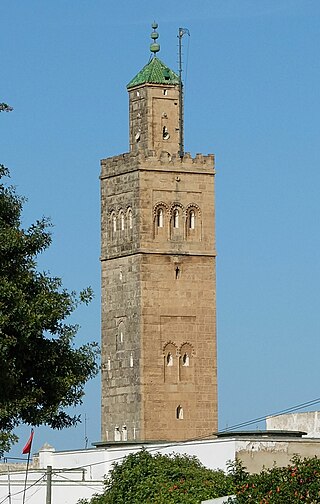
The Great Mosque of the medina of Rabat in Morocco, also known as the el-Kharrazin Mosque, is the largest Friday mosque within the historic Andalusian medina of Rabat in Morocco. The mosque is located at the intersection of the streets of Souk Sebbat and Rue Bab Chellah.
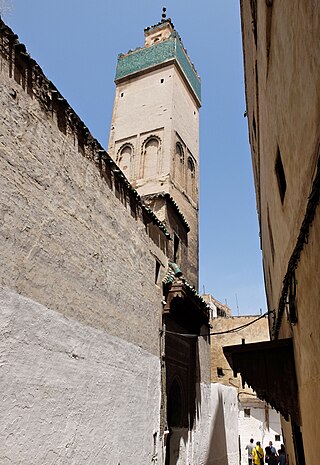
The Zawiya of Sidi Taoudi Ben Souda is a zawiya and mosque in Fes el-Bali, the old medina of Fes, Morocco. It is named after Muḥammad al-Tāwdī Ibn al-Ṭālib Ibn Sūda al-Murrī, an 18th-century Sufi sheikh who is considered by some to be one of the foremost intellectuals and Muslim scholars of Morocco's history.






















